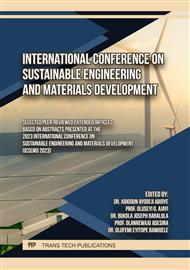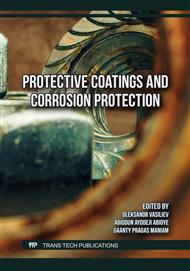[1]
J. Eastman, U. S. Choi, S. Li, L. J. Thompson and S. Lee, Enhanced Thermal Conductivity Through the Development of Nanofluids, MRS Proceedings 457 (1996).
DOI: 10.1557/proc-457-3
Google Scholar
[2]
A. O. Borode, N. A. Ahmed and P. A. Olubambi, Surfactant-aided dispersion of carbon nanomaterials in aqueous solution, Phys. Fluids 31 (2019) 071301.
DOI: 10.1063/1.5105380
Google Scholar
[3]
F. Yu, Y. Chen, X. Liang, J. Xu, C. Lee, Q. Liang, P. Tao and T. Deng, Dispersion stability of thermal nanofluids, Prog. Nat. Sci. Mater. Int. 27 (2017) 531–542.
DOI: 10.1016/j.pnsc.2017.08.010
Google Scholar
[4]
W. Yu and H. Xie, A Review on Nanofluids: Preparation, Stability Mechanisms, and Applications, Journal of Nanomaterials, 2012 (2012) 17.
Google Scholar
[5]
A. O. Borode, N. A. Ahmed and P. A. Olubambi, A review of heat transfer application of carbon-based nanofluid in heat exchangers, Nano-Structures & Nano-Objects 20 (2019) 100394.
DOI: 10.1016/j.nanoso.2019.100394
Google Scholar
[6]
T.-P. Teng, Y.-B. Fang, Y.-C. Hsu and L. Lin, Evaluating Stability of Aqueous Multiwalled Carbon Nanotube Nanofluids by Using Different Stabilizers %J Journal of Nanomaterials, J. Nanomater. 2014 (2014) 15.
DOI: 10.1155/2014/693459
Google Scholar
[7]
R. Lotfi, A. M. Rashidi and A. Amrollahi, Experimental study on the heat transfer enhancement of MWNT-water nanofluid in a shell and tube heat exchanger, Int. Commun. Heat Mass Transf. 39 (2012) 108–111.
DOI: 10.1016/j.icheatmasstransfer.2011.10.002
Google Scholar
[8]
R. Walvekar, M. K. Siddiqui, S. Ong and A. F. Ismail, Application of CNT nanofluids in a turbulent flow heat exchanger, J. Exp. Nanosci. 11 (2016) 1–17.
DOI: 10.1080/17458080.2015.1015461
Google Scholar
[9]
M. H. Bahmani, G. Sheikhzadeh, M. Zarringhalam, O. A. Akbari, A. A. A. A. Alrashed, G. A. S. Shabani and M. Goodarzi, Investigation of turbulent heat transfer and nanofluid flow in a double pipe heat exchanger, Adv. Powder Technol. 29 (2018) 273–282.
DOI: 10.1016/j.apt.2017.11.013
Google Scholar
[10]
A. O. Borode, N. A. Ahmed and P. A. Olubambi, Application of Carbon-based Nanofluids in Heat Exchangers: Current Trends, J. Phys. Conf. Ser. 1378 (2019) 032061.
DOI: 10.1088/1742-6596/1378/3/032061
Google Scholar
[11]
M. A. Khairul, K. Shah, E. Doroodchi, R. Azizian and B. Moghtaderi, Effects of surfactant on stability and thermo-physical properties of metal oxide nanofluids, Int. J. Heat Mass Transf. 98 (2016) 778–787.
DOI: 10.1016/j.ijheatmasstransfer.2016.03.079
Google Scholar
[12]
W. W. BINGER and H. W. FRITTS, Aluminum Alloy Heat Exchangers In the Process Industries, CORROSION 10 (1954) 425–431.
DOI: 10.5006/0010-9312-10.12.425
Google Scholar
[13]
K. K. Sankaran and R. S. Mishra, Aluminum Alloys, in Metallurgy and Design of Alloys with Hierarchical Microstructures (Elsevier, 2017). 57–176.
DOI: 10.1016/b978-0-12-812068-2.00004-7
Google Scholar
[14]
V. Guillaumin and G. Mankowski, Localized corrosion of 6056 T6 aluminium alloy in chloride media, Corros. Sci. 42 (2000) 105–125.
DOI: 10.1016/s0010-938x(99)00053-0
Google Scholar
[15]
R. Parvizi, M. Y. Tan and A. E. Hughes, Recent Insights Into Corrosion Initiation at the Nanoscale, Fundam. Alum. Metall. (2018) 525–551.
DOI: 10.1016/b978-0-08-102063-0.00014-x
Google Scholar
[16]
V. Srinivas, C. V. K. N. S. N. Moorthy, V. Dedeepya, P. V. Manikanta and V. Satish, Nanofluids with CNTs for automotive applications, Heat Mass Transf. 52 (2016) 701–712.
DOI: 10.1007/s00231-015-1588-1
Google Scholar
[17]
A. Rashidi, A. Amrollahi, R. Lotfi, H. Javaheryzadeh, H. Rahimi, A. R. Rahimi and A. Jorsaraei, An investigation of electrochemical behavior of nanofluids containing MWCNT on the corrosion rate of carbon steel, Mater. Res. Bull. 48 (2013) 4438–4443.
DOI: 10.1016/j.materresbull.2013.07.042
Google Scholar
[18]
A. F. Ismail, A. Anuar, W. Rashmi and T. Yusaf, Corrosion effects of CNT-nanofluids on different metals, WIT Trans. Eng. Sci. (2014).
DOI: 10.2495/amitp130171
Google Scholar
[19]
Q. Yuan, H.-H. Ge, J.-Y. Sha, L.-T. Wang, C. Wan, F. Wang, K. Wu, X.-J. Meng and Y.-Z. Zhao, Influence of Al2O3 nanoparticles on the corrosion behavior of brass in simulated cooling water, J. Alloys Compd. 764 (2018) 512–522.
DOI: 10.1016/j.jallcom.2018.06.035
Google Scholar
[20]
J.-Y. Sha, H.-H. Ge, C. Wan, L.-T. Wang, S.-Y. Xie, X.-J. Meng and Y.-Z. Zhao, Corrosion inhibition behaviour of sodium dodecyl benzene sulphonate for brass in an Al2O3 nanofluid and simulated cooling water, Corros. Sci. 148 (2019) 123–133.
DOI: 10.1016/j.corsci.2018.12.006
Google Scholar
[21]
M. Baghalha and M. Kamal-Ahmadi, Copper corrosion in sodium dodecyl sulphate solutions and carbon nanotube nanofluids: A modified Koutecky-Levich equation to model the agitation effect, Corros. Sci. 53 (2011) 4241–4247.
DOI: 10.1016/j.corsci.2011.08.035
Google Scholar
[22]
F. Kellou-Kerkouche, A. Benchettara and S. Amara, Effect of sodium dodecyl benzene sulfonate on the corrosion inhibition of Fe-1Ti-20C alloy in 0.5 M H2SO4, Mater. Chem. Phys. 110 (2008) 26–33.
DOI: 10.1016/j.matchemphys.2008.01.005
Google Scholar
[23]
Y. Li, X. Lu, K. Wu, L. Yang, T. Zhang and F. Wang, Exploration the inhibition mechanism of sodium dodecyl sulfate on Mg alloy, Corros. Sci. 168 (2020) 108559.
DOI: 10.1016/j.corsci.2020.108559
Google Scholar
[24]
K. Azzaoui, E. Mejdoubi, S. Jodeh, A. Lamhamdi, E. Rodriguez-Castellón, M. Algarra, A. Zarrouk, A. Errich, R. Salghi and H. Lgaz, Eco friendly green inhibitor Gum Arabic (GA) for the corrosion control of mild steel in hydrochloric acid medium, Corros. Sci. 129 (2017) 70–81.
DOI: 10.1016/j.corsci.2017.09.027
Google Scholar
[25]
K. Ramji, D. R. Cairns and S. Rajeswari, Synergistic inhibition effect of 2-mercaptobenzothiazole and Tween-80 on the corrosion of brass in NaCl solution, Appl. Surf. Sci. 254 (2008) 4483–4493.
DOI: 10.1016/j.apsusc.2008.01.031
Google Scholar
[26]
B. M. Paramashivaiah and C. R. Rajashekhar, Studies on effect of various surfactants on stable dispersion of graphene nano particles in simarouba biodiesel, IOP Conf. Ser. Mater. Sci. Eng. 149 (2016) 012083.
DOI: 10.1088/1757-899x/149/1/012083
Google Scholar
[27]
A. K. M. Mahmudul Haque, S. Kwon, J. Kim, J. Noh, S. Huh, H. Chung and H. Jeong, An experimental study on thermal characteristics of nanofluid with graphene and multi-wall carbon nanotubes, J. Cent. South Univ. 22 (2015) 3202–3210.
DOI: 10.1007/s11771-015-2857-3
Google Scholar
[28]
R. Mehdaoui, A. Khelifa, A. Khadraoui, O. Aaboubi, A. Hadj Ziane, F. Bentiss and A. Zarrouk, Corrosion inhibition of carbon steel in hydrochloric acid solution by some synthesized surfactants from petroleum fractions, Res. Chem. Intermed. 42 (2016) 5509–5526.
DOI: 10.1007/s11164-015-2383-9
Google Scholar
[29]
I. Arukalam, I. Madufor, O. Ogbobe and E. Oguzie, Understanding the Influence of Molecular Weight on the Corrosion Inhibition Performance of Two Cellulosic Polymers, Am. Chem. Sci. J. 10 (2016) 1–14.
DOI: 10.9734/acsj/2016/16664
Google Scholar
[30]
B. Xu, W. Yang, Y. Liu, X. Yin, W. Gong and Y. Chen, Experimental and theoretical evaluation of two pyridinecarboxaldehyde thiosemicarbazone compounds as corrosion inhibitors for mild steel in hydrochloric acid solution, Corros. Sci. 78 (2014) 260–268.
DOI: 10.1016/j.corsci.2013.10.007
Google Scholar
[31]
C. Lai, B. Xie, L. Zou, X. Zheng, X. Ma and S. Zhu, Adsorption and corrosion inhibition of mild steel in hydrochloric acid solution by S-allyl-O,O'-dialkyldithiophosphates, Results Phys. 7 (2017) 3434–3443.
DOI: 10.1016/j.rinp.2017.09.012
Google Scholar
[32]
A. EL Mazyani, M. Chafi and M. Essahli, Assessment of AA5005 aluminum alloy corrosion resistance by Direct Blue 15 inhibitor in sodium chloride medium, Mater. Today Proc. (2020).
DOI: 10.1016/j.matpr.2020.08.473
Google Scholar
[33]
F. Kellou-Kerkouche, A. Benchettara and S.-E. Amara, Anionic Surfactant as a Corrosion Inhibitor for Synthesized Ferrous Alloy in Acidic Solution, J. Mater. 2013 (2013) 1–11.
DOI: 10.1155/2013/903712
Google Scholar
[34]
A. Peter, I. B. Obot and S. K. Sharma, Use of natural gums as green corrosion inhibitors: an overview, International Journal of Industrial Chemistry vol. 6 (2015) 153–164.
DOI: 10.1007/s40090-015-0040-1
Google Scholar
[35]
Y. Qiang, S. Zhang, L. Guo, S. Xu, L. Feng, I. B. Obot and S. Chen, Sodium dodecyl benzene sulfonate as a sustainable inhibitor for zinc corrosion in 26% NH4Cl solution, J. Clean. Prod. 152 (2017) 17–25.
DOI: 10.1016/j.jclepro.2017.03.104
Google Scholar
[36]
M. A. A.-E.-F. B. A. Abd-El-Nabey, S. El-Housseiny, H. M. El-Kshlan, Effect of Tween-80 Surfactant on the Corrosion Resistance of Zn-Phosphated Steel, Physical Chemistry vol. 7 (2017). 17–26.
Google Scholar
[37]
R. Mehdaoui, A. Khadraoui, A. Khelifa, K. Chouchane and A. Zerrouk, EIS Studies of Anionic Surfactants Inhibiting Effect of Al-2017 Corrosion in HCl Aqueous Solutions, J. Mater. Sci. Eng. A 7 (2017).
DOI: 10.17265/2161-6213/2017.9-10.004
Google Scholar
[38]
L. Yin, W. Li, Y. Wang, Y. Jin, J. Pan and C. Leygraf, Numerical simulation of micro-galvanic corrosion of Al alloys: Effect of density of Al(OH)3 precipitate, Electrochim. Acta 324 (2019) 134847.
DOI: 10.1016/j.electacta.2019.134847
Google Scholar
[39]
E. E. Oguzie, G. N. Onuoha and A. I. Onuchukwu, The inhibition of aluminium corrosion in potassium hydroxide by 'Congo Red' dye, and synergistic action with halide ions, Anti-Corrosion Methods and Materials vol. 52 (2005) 293–298.
DOI: 10.1108/00035590510615794
Google Scholar
[40]
P. D. Reena Kumari, J. Nayak and A. Nityananda Shetty, 3-ethyl-4-amino-5-mercapto-1,2,4-triazole as corrosion inhibitor for 6061-alloy in sodium hydroxide solution, Port. Electrochim. Acta 29 (2011) 445–462.
DOI: 10.4152/pea.201106445
Google Scholar
[41]
M. Jayalakshmi and V. S. Muralidharan, Inhibitors for Aluminium Corrosion in Aqueous Medium, Corros. Rev. 15 (1997) 315–340.
DOI: 10.1515/corrrev.1997.15.3-4.315
Google Scholar
[42]
S. Il Pyun and S. M. Moon, Corrosion mechanism of pure aluminium in aqueous alkaline solution, J. Solid State Electrochem. 4 (2000) 267–272.
DOI: 10.1007/s100080050203
Google Scholar
[43]
S. M. Moon and S. Il Pyun, The formation and dissolution of anodic oxide films on pure aluminium in alkaline solution, Electrochim. Acta 44 (1999) 2445–2454.
DOI: 10.1016/s0013-4686(98)00368-5
Google Scholar
[44]
R. W. Revie and H. H. Uhlig, Corrosion and Corrosion Control, Corrosion and Corrosion Control: An Introduction to Corrosion Science and Engineering: Fourth Edition (John Wiley & Sons, Inc., 2008).
DOI: 10.1002/9780470277270
Google Scholar
[45]
S. Wang, Y. Gu, Y. Geng, J. Liang, J. Zhao and J. Kang, Investigating local corrosion behavior and mechanism of MAO coated 7075 aluminum alloy, J. Alloys Compd. 826 (2020) 153976.
DOI: 10.1016/j.jallcom.2020.153976
Google Scholar



